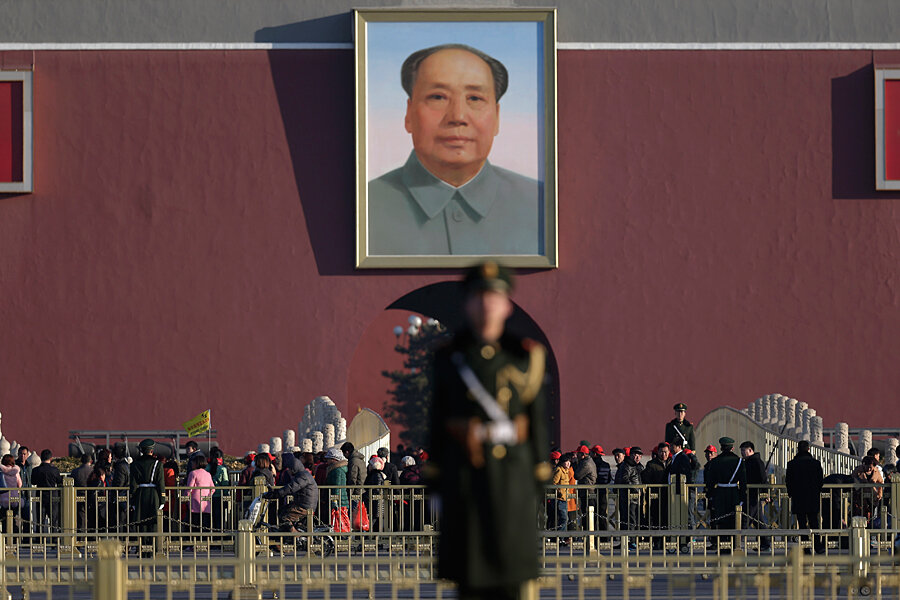China to dancing grannies: Step in line, quietly
Loading...
| Beijing
The Chinese government has had enough. A decree has gone out. The armies of dancing grannies who fill the country’s parks and plazas every morning and evening, deafening passers-by with their music, must fall in line.
Henceforth, officials announced on Monday, the tens of millions of older women who make a noisy habit of public square dancing must stick to 12 approved choreographed routines.
The new regulation’s efficacy remains to be seen. Wherever you go in China, as dawn breaks or dusk falls, you find groups of women – sometimes several hundred strong – shuffling, hopping, swaying, and shaking in unison. They dance to kitschy Canto-pop tunes, folk melodies, disco, saccharine hit songs of the moment and stirring anthems from the distant days of the Cultural Revolution. It’s a mix of aerobic workout, social promenade, and devil-may-care insouciance.
Whichever style of music they choose, it is always ear-splittingly loud, usually relayed by a boombox that accentuates the tinny rhythms.
The government is anxious to cool the mounting social tensions that this is provoking in towns and cities across the nation. Angry residents whose windows open onto retiree dance floors have been known to set dogs on dancing women and to pour water, or worse, over them.
Such disputes, say researchers, mark the stress lines in a rapidly changing society. A generation of women, mostly between 55 and 65, grew up in the collectivist Maoist era and still enjoy doing things together in public – such as dancing in squares, parks, and empty lots.
Ranged against them are younger, wealthier, and more sophisticated Chinese accustomed to a more private lifestyle. They complain that they can’t hear themselves think in their own apartments.
“The biggest conflict is between notions of individual freedom and collectivism,” says Mi Li, a teacher at Central South University in Hunan province who is writing a book about the square dancing phenomenon. “The women don’t even see how they are a nuisance. Younger people don’t understand collectivism.”
Standards and regulations
“Square dancing represents the collective aspect of Chinese culture, but now it seems that the over-enthusiasm of participants has dealt it a harmful blow with disputes over noise and venues,” declared Liu Guoyong, chief of the General Administration of Sport’s mass fitness department as he announced the new rules, according to the official China Daily. “So we have to guide it with national standards and regulations.”
Twelve official drills have been choreographed, he explained, and 600 specially trained instructors will fan out across the country over the next five months to introduce them to the dancing women known popularly as da ma or “big mamas.” State television and scholars estimate that there could be as many as 100 million of them.
That is all very well, says Prof. Mi. “These women are used to taking orders from the country. They will probably accept this kind of guidance and learn the official routines. But they will also find other new tunes that they like on the Internet and they will dance to them too; there will be one official system and one unofficial system.”
The real problems, Mi says, are the anti-social hours that the square dancers keep, the volume of their music, and the fact that they dance in residential areas. No standards to regulate these questions have been worked out, reported the China Daily, citing a senior Culture Ministry official.
The hours kept by da ma reflect the rhythms of the countryside, a timetable that may be out of step with an increasingly urban society. The number of Chinese living in towns and cities surpassed those in rural areas for the first time in 2011.
Noise control vs physical health
The problem has spread across the Pacific. In 2013 one Chinese woman was arrested in Sunset Park in New York for leading a group of dancers whose loudspeakers were exceeding the city’s 45-decibel limit in a public place.
“But in China there is no way to transplant this efficient means of noise control,” argues Zhang Xiaochi, a professor at the School of Foreign Languages in the southwestern province of Sichuan, in an academic paper he wrote analyzing the incident. “This might lock up millions of the square dancing da ma.”
Though some Chinese cities have tried to impose limits on the da ma “it’s really hard,” says Mi. “These women occupy every public space,” she points out, “and they say that’s because the government doesn’t give them anywhere else to practice.
“They can’t live without it,” she adds. “It’s a good opportunity for them to socialize and to express themselves; in China women have fewer chances than men to express their needs. This dancing is not just good for their physical health, it’s good for their psychological wellbeing too. It’s their cure for loneliness.”
However the authorities decide to cope with the problem, it is not going away. Predictions based on the 2010 census suggest that there will be nearly 210 million women over 55 in China in 2020. If you are planning a visit, bring your earplugs.








